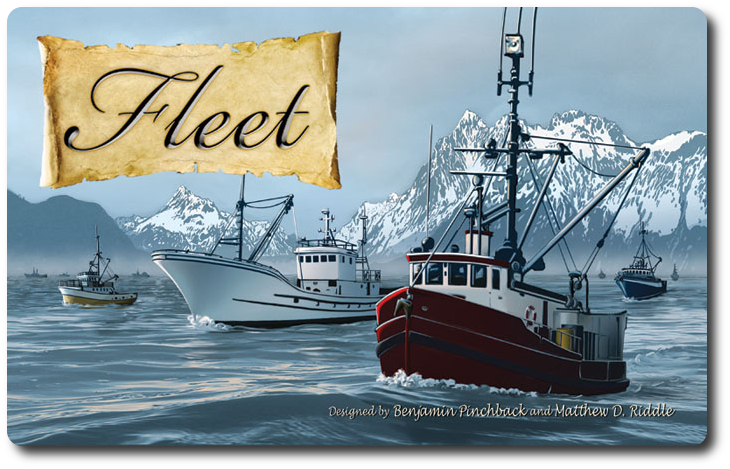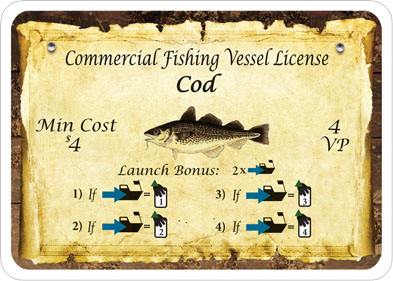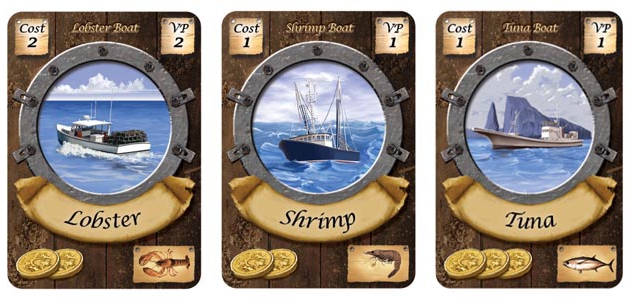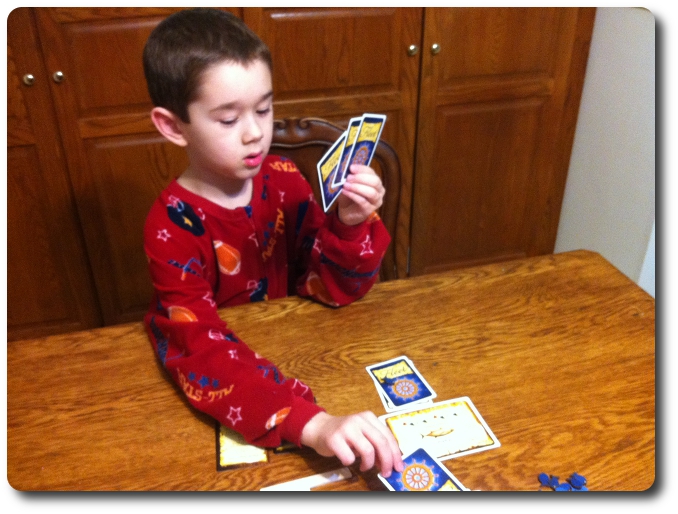Please Take Note: This is a review of the game’s final prototype. The art, game bits, and the rules discussed are all subject to change. The game is being reviewed on the components and the rules provided with the understanding that “what you see is not what you might get” when the game is published. If you like what you read and want to learn more, we encourage you to visit the Kickstarter project page to back it and get yourself a copy! Now that we have all that disclaimer junk out of the way, on with the review!

The Basics:
- For ages 7 and up (designer suggests 10+)
- For 2 to 4 players
- About 45 minutes to complete
Geek Skills:
- Counting & Math
- Logical & Critical Decision Making
- Reading
- Pattern Matching
- Strategy & Tactics
- Risk vs. Reward
- Hand/Resource Management
- Auctioning, Bidding, & Trading
Learning Curve:
- Child – Moderate
- Adult – Easy
Theme & Narrative:
- The ocean’s treasure awaits the brave and entrepreneurial
Endorsements:
- Gamer Geek approved!
- Parent Geek approved!
- Child Geek approved!
Overview
Henry David Thoreau once said “many men go fishing all of their lives without knowing that it is not fish they are after.” Is it the tranquility of the rolling waves that sends men and women out to sea or the lure of wealth? Be they crew or captain, they board their vessels and make their way by compass and instinct, farming the ocean for its bounty. Wealth is a given for those who know how to read the waters and pierce the mysteries of its depths. For others, it is just luck. For you, it will be both. Buy your license, hire your captain, and set out to find your fortune. The race has begun.
Fleet is comprised of 96 Boat cards, 26 License cards, 4 Turn Explanation cards, 100 Fishing Crates, and 1 Starting Player marker. The artwork is superb, capturing the theme of the game perfectly. Most of the information on the cards is communicated through icons that are intuitive. What little wordage there is on the cards is easy to read. For a prepublished version of the game, I am greatly impressed at the time and energy spent on it.
The Cards
The game phases determines how the cards are used. Knowing how to use your cards and when is essential in order to achieve victory.
License Cards
The License cards serve two primary purposes in the game. The first determines what the player is able to fish during the fishing phase. This, in turn, determines what types of boats the player can use. The second is referred to as the “license bonus”. The first license collected will provide the owning player a small bonus, but by collecting additional licenses of the same type, that bonus increases. The player is always welcome to collect a variety of licenses to diversify their fleet, but a fisherman who focuses on a single type will be rewarded for their determination.

Example License card
License bonuses can be a reduction in prices, the ability to launch more than one boat, card draw bonuses, and income bonuses. Each bonus is unique to the license and only improves when the player invests their time in acquire the same license again and again. Licenses also award the player Victory Points (VP) at the end of the game, and a few special premium licenses, while expensive, will greatly improve the player’s chances of winning if played correctly.
Boat Cards
Boat cards are at the center of the game and are the most useful commodity available to the player, but the cards are not worth a cent unless they are playable using License cards. Each Boat card provides the player a wealth of information without being overwhelming. This is because the information each card provides is specific to which phase the game is currently in. In total, each Boat card provides 4 specific and important pieces of information. They are as follows:
- License/Boat Type: each License card must be matched to a boat that can fish for what the license provides. For example, a Shrimp boat can only be attached to a Shrimp license.
- Launch Cost: this is the amount of cash a player must spend in order to attach their Boat card to a matching License.
- Cash Value: this represents the total cash value the card provides. This used when auctioning for licenses and launching boats.
- Victory Points (VP): this lists the amount of points the card is worth if it is launched by the time the game ends.

Example Boat cards
Game Set Up
To set up the game, first separate the License and Boat cards. Give the players one of each Boat card type (1 Shrimp, 1 Cod, 1 King Crab, 1 Tuna, 1 Lobster, and 1 Processing Vessel). The remaining Boat cards are shuffled and placed in the middle of the playing area, face-down. This is the now the Boat deck. If at anytime this deck is depleted, reshuffle the discarded Boat cards and form a new deck.
Depending on the number of players, you will do the following with the License cards:
- For a 2-Player Game: find and separate the 6 premium licenses and 10 randomly selected common License cards. From these cards, randomly select 3 premium licenses and 6 common licenses. These cards are removed for the duration of the game. Shuffle the 3 remaining premium licenses into the pile of common License cards. Then randomly place the 4 remaining common licenses on top of the License card stack, face-up in the middle of the playing area.
- For a 3-Player Game: find and separate the 6 premium licenses and 8 randomly selected common License cards. From these cards, randomly select 2 premium licenses and 2 common licenses. These cards are removed for the duration of the game. Shuffle the 4 remaining premium licenses into the pile of common License cards. Then randomly place the 6 remaining common licenses on top of the License card stack, face-up in the middle of the playing area.
- For a 4-Player Game: find and separate the 6 premium licenses and 8 randomly selected common License cards. Shuffle the 6 premium licenses into the pile of common License cards. Then randomly place the 8 remaining common licenses on top of the License card stack, face-up in the middle of the playing area.
Once the License card stack has been created, take a number of License cards from the top of the stack equal to the number of players and place them, face-up, on the table. These are the starting licenses available for the players to bid on.
Lastly, count and place to the side a number of Fish Crates as needed depending on the number of players. These Fish Crates should be placed within easy reach of all players. Any unused Fish Crates are removed from the game.
- For a 2-Player Game: use 50 Fish Crates
- For a 3-Player Game: use 75 Fish Crates
- For a 4-Player Game: use all 100 Fish Crates
There is an optional “advanced set up” that can be used by players if they like. The advanced set up states you randomly shuffle all the premium and common License cards together after any are removed based on the number of players in the game. When placing the initial licenses for bidding, any premium licenses revealed should be shuffled back in the stack until only common License cards are available. This is done only for the initial bidding round.
Give the first player starter marker to one of the players and begin!
Let’s Go Fishing!
Game play is actually exceptionally simple but some much needed thought is needed in each phase of the game if the player wants to seriously compete. The game is played in rounds and each round has five phases.
Phase 1: License Auction
- Starting with the first player, a single License is selected to be bid on and an opening bid is verbally made. The opening bid must be equal to or higher than the minimum cost listed on the License card.
- Players now take turns, going clock-wise, bidding on the license. Each bid must be higher than the last. Players cannot bid on a license they cannot afford.
- If a player passes, they are out for the duration of this license bid.
- Bidding continues until there is a high bidder.
- The appropriate number of Boat cards are discarded and any Fish Crates used as currency to help pay for the bid are removed from the game.
- A new License card is now bid on, but any player who has already purchased a license is out for the duration of this phase.
- If it is a player’s turn and they choose not to provide an opening bid, they are out for the duration of this phase.
- Once everyone has either passed or all licenses are purchased, the available licenses are refreshed from the stack and a number of License cards equal to the number of players are placed.
- Any licenses won during this phase are immediately collected and put “in play” in front of the owning player.
Phase 2: Launch Boats and Hire Captains
- Players place a single Boat card that matches that license and must pay the launching cost with their Boat cards or using Fish Crates. Boat cards are discarded and Fish Crates used are removed from the game. Once paid for, this boat is considered “launched”. Only one boat can be launched per round per player.
- Players can then hire captains for their boats. This is done by the player placing any of their Boat cards face-down on a launched boat without a face-down card on it. This boat now has a captain. Only one captain can be hired per round.
- Multiple boats can use the same license.
Phase 3: Fishing
- Each launched boat with a captain is given 1 Fish Crate which is placed on the boat.
- All boats can hold no more than 4 Fish Crates.
- If a boat already has 4 Fish Crates, it can hold no more and receives nothing this round.
Phase 4: Processing and Trading
- Players, in turn order, can take one Fish Crate per boat and place it on their Process Vessel License card.
- A player can now choose to spend 1 Fish Crate to draw 1 Boat card. The Fish Crate used is removed from the game.
- All remaining Fish Crates can be used later to help bid or pay for boat launches. Each Fish Crates counts as $1. Any Fish Crates used as cash are removed from the game.
Phase 5: Draw Cards
- In turn order, each player draws 2 Boat cards.
- The first player marker is passed to the next player and a new round begins.
Note that this continues until the endgame condition is met. Players should pay close attention to their License cards because they might receive bonus cards and actions during one or more of the above phases of the game.
Endgame
The game continues until one of the two following conditions are met.
- Not enough License cards to refresh the available licenses for all the players at the end of phase 1. Once this happens, the game round is completed and Victory Points are counted.
- No more Fish Crates available during phase 3. Once this happens, the phase is completed (not the round) and the Victory Points are counted. Any Fish Crates that a player would have received still count as points.
Counting Fish
Once the endgame condition has been met, the Victory Points are counted. The player with the most Victory Points wins! Each player counts the following.
- Total number of Victory Points on their License cards
- Total number of Victory Points on launched boats
- Total number of Fish Crates on boats (not Process Vessel license)
- Any bonus VP provided by a License card
To learn more about the game, visit the official Kickstarter project page.
Prediction
My oldest little geek, age 7, has in the last 6 months or so become interested in games where math is involved. I imagine this is because he has become better at it and he has more confidence in his ability. It was only a year or so ago that he would turn his nose up to any game that required heavy-duty counting and I would spend longer convincing him to try the game than it would take me to play the game.
Oh, how the times have changed.
One game he greatly enjoys at the moment is For Sale, where players bid for houses and then attempt to sell them for the most money. This game is simple in play but requires the player to do some math in their head, determining their level of risk and reward. I also like this game a great deal and think it is an excellent introduction to auctioning and bidding. Using what he has learned in this game and playing Settlers of Catan, I have no doubt he will enjoy it.
When I pitched the game to my 7-year-old, he was immediately drawn to the artwork. Again, I know this is a prepublished version of the game, but the level of detail and TLC put into it so far is outstanding. This was not lost on my little geek who wanted to see the box the game came in. When I showed him nothing more than an empty packaging envelope, he thought I was joking. The game already looks professionally published and ready to go!
The game play is rather straight forward for Fleet. This made it easy to teach to my little geek and it didn’t take him long to understand what each phase in the round was about. We went through several examples of and a test hand so he could understand how the cards worked and what was required of him. When he (and I) felt confident in his ability to play the game, I set it up for our first real game play experience. While I did so, I asked him his thoughts on the game so far.
“I really like how you get to go fishing for crabs and shrimp. I don’t like fishing, but I like how this game looks.” ~ Liam (age 7)
Well, alright! We have an enthusiastic little geek on our hands a game ready to play! Let’s get this boat in the water and see if she sinks or stays afloat.
Final Word
My little geek and I had a great time playing Fleet. It plays light and fast, but is surprisingly challenging and potentially frustrating as you wait for that one card you need or suddenly realize you just played the card you really could have used. At first, the multiple use of the cards really confused my 7-year-old and he made choices and played cards based on what he had to do in each phase. This is not a good way to play the game. The best way to play is to consider all the possibilities available to you based on all the information you are given each round. This is an aspect of the game I know I enjoyed as it made me really stop and consider my strategy and tactics.
When it became apparent that my little geek was not seeing a “big picture”, I stopped the game and we talked a bit about what the game was about. It helped that Fleet has a theme and narrative that is easy for a little geek’s mind to grasp and visualize. We discussed the logic of each phase and why it was important to consider phase 1 to phase 5 as a complete player’s turn instead of five different steps. He recognized what he was doing and told me how he was going to play differently. Instead of focusing on the action of the phase, he was going to focus on the goal of the round. This greatly pleased me to hear him talk his way through it and once again demonstrated to me what an absolutely brilliant gamer he is going to become.
With adults, Fleet plays like a dream. The information available to all the players on the table makes it easy to see where your competition is making headway and how far off you are from the mark. Victory Points are easily calculated and the timing of the endgame is simple math. This puts a lot of control in the hands of the players and makes the game a real thinker as you attempt to outmaneuver your opponents. Accepting risk is a delightful challenge in the game as you purchase licenses in hopes of either diversifying your fleet or collecting the same license for the bonuses. Both strategies work well if they are played right.
Playing “right” is based on two important aspects of the game. The first is the other players. Depending on where they are putting their focus, you will need to adjust your strategy to overcome any gaps in Victory Points. The second is the randomness of the cards and their multiple use. You will simply never have a card you cannot use in the game. Every card in worth keeping and, more importantly, spending. You will start to feel frustrated when you can’t seem to get a Boat card that matches your license (which is why many choose to diversify their fleet) and you will mentally kick yourself when you realize you should have kept a card in an earlier phase through the magic of hindsight.
And therein lies the real charm of Fleet. It starts light and shallow and then progresses into a surprisingly deep and heavy game. The longer you play it, the more you have to manage. The more you have to manage, the more you have to think about each round and each phase in that round. The steady increase in difficulty sneaks up on you. This made teaching the game to little geeks and big geeks easy as the concepts and actions in the game are not complicated at first. The challenge when introducing this game to new players and non-gamers is keeping everyone on task. Vapor lock is almost a given towards the end of the game when it becomes painfully obvious that every card is worth playing and keeping.

My little geek contemplates his next "Catch of the Day"
Gamer Geeks, this is a fun auction and bidding game that plays light but provides more than enough challenge to keep you engaged and excited. The choices you can or cannot make are all dependent on the cards in your hand which you must manage well in order to succeed. There is a steady increase in difficulty as the game progresses but there is always room for adjusting strategy and tactics. The only limiting factors of the game are the cards available to you each round and the game’s length. If you are playing with especially aggressive players, the game’s overall time will be greatly reduced which will make the game a frantic race to set sail and fish as quickly as possible. Different play styles are encouraged and you will have an excellent time exploring all the possible paths to victory.
Parent Geeks, this is a wonderful game you can play with the family, is challenging, but not out of reach. Even non-gamers will be able to grasp the goal and game play of Fleet with little in the way of difficulty. What will elude many at first is the need to keep an end goal in mind at all times and spend the cards appropriately to obtain that goal. Luckily for all, there is never a bad card in your hand and there is always something a player can do. Hand management will become all important as the game progresses.
Child Geeks, this is one of those games that will teach you as you play it. The lessons might seem a bit harsh at times as you are forced to play cards you want to keep or realize you don’t have the cards you want to spend. Everyone is in the same boat, figuratively speaking. Players must spend cards in order to progress in the game and even the smallest of steps forward is a step in the right direction. Expect to be challenged but not shackled. You are the boss and get to make all the choices. This will give you a wonderful feeling of responsibility but it can also be easy to feel overwhelmed. Don’t be. Each round is broken down into simple steps. Look at the game as a simple act of climbing a flight of stairs. One step at a time until you reach the top and victory!
I greatly enjoy Fleet and find it to be a challenging game that plays light and has a great deal of replay value. The random game set up and Boat cards in your hand will always keep things new. There are enough different ways to play the game to make changing strategy and tactics a worthwhile venture but not so open as to make it impossible to consider all your choices. There is a defined boundary but there is enough depth to keep one happily busy. My only issue with the game is its length. I want the game to be longer, as silly as that sounds. Not because I am having trouble with the game, but because I am having so much fun playing the game!
If Fleet sounds like a game you, your friends, and your family would enjoy, you can get into the action over at Kickstarter and get yourself a copy. Fun times at your table are guaranteed.
This game was given to Father Geek as a review copy. Father Geek was not paid, bribed, wined, dined, or threatened in vain hopes of influencing this review. Such is the statuesque and legendary integrity of Father Geek.




Thank you for your amazing review. Not just that you liked Fleet, but that you clearly spent time and effort on this review. Thank you!
We spent time, energy, effort, and brain power.
Thanks for the great game and best of luck to you with your Kickstarter project!